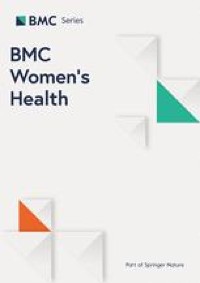Impact of individual and environmental factors on academic performance of pregnant adolescent – BMC Women’s Health
Impact of individual and environmental factors on academic ... BioMed Central


Sustainable Development Goals and Teenage Pregnancies in Nigeria

Introduction
Teenage pregnancies are a public health challenge in both developed and developing countries. According to global records, nearly 21 million teenage girls become pregnant each year, 10 million of them unintentionally [1]. Sub-Saharan Africa accounts for 95% of the world’s adolescent population [2]. Nigeria is one of the countries with the highest incidence of teenage pregnancy in sub-Saharan Africa and West Africa [3]. An estimated 45% of girls aged 15–19 are sexually active [3] and 23% of this group already have a child [4]. In addition, 1.3 million adolescent girls in Nigeria drop out of school every year [5]. A significant 7.3 million girls are excluded from access to education in Nigeria each year [6].
Causes and Consequences of Teenage Pregnancies
Some of the causes of teenage pregnancies in Nigeria are limited access to sexual health services, low knowledge of contraceptives and their use, unequal distribution of health infrastructure and services, and inadequate knowledge about sexual and reproductive health [7][8][9]. Teenage pregnancies are considered a leading cause of maternal and child deaths, school dropout, unemployment, and poverty among teenage mothers worldwide [1][10][11]. Studies have linked neighbourhood poverty, negative peer influence, weak parental control and relationships, lack of sexual health knowledge, and risky sexual practices to causes of unwanted pregnancies [12][13].
Impact on Academic Performance
Pregnant students’ decisions to continue or discontinue their studies may depend on their academic performance [17]. Pregnant female students often face hostility, stigma, and ridicule from both teachers and peers, which reduces their motivation to learn [18]. This, along with other difficulties, increases the likelihood of school dropout among pregnant teenage girls. The lack of support for academic achievement can be seen as a violation of the basic human right to education [5]. Furthermore, teenage pregnancies deny females their rights to social and economic prospects, leading to domestic violence, lack of sexual autonomy, child marriage, unemployment, and poverty [5][6].
Factors Affecting Academic Performance
Several factors have been identified as predictors of academic progress among expectant adolescents. These include peer attachment and sexual attitudes. Peer attachment is important as adolescents seek validation and acceptance from peers during their developmental years [25]. Positive peer relationships can positively influence academic achievement, while negative peer influence can hinder academic success [25]. Sexual attitudes, especially in the context of sexual engagement and non-use of contraceptives, can also affect academic performance [24][26][27].
Importance of the Environment
The environment plays a crucial role in shaping the development of adolescents. The quality of the environment, including access to education, healthcare, and community activities, can predict academic performance and health behaviors [34][35][36]. The neighborhood environment can also influence peer relationships, which in turn can affect attitudes towards sexual activity and academic success [40][41].
Conclusion
Teenage pregnancies continue to threaten the education and academic integration of pregnant teenage female students in Nigeria. Addressing the individual and environmental factors that affect academic performance is crucial in developing social intervention strategies for the integration of pregnant adolescent students into the academic space. These strategies can align with Sustainable Development Goals 3 and 6, which aim to improve women’s education, equality, and quality of life.
SDGs, Targets, and Indicators
| SDGs | Targets | Indicators |
|---|---|---|
| SDG 3: Good Health and Well-being | Target 3.7: By 2030, ensure universal access to sexual and reproductive health-care services, including for family planning, information and education, and the integration of reproductive health into national strategies and programmes | Indicator: Percentage of teenage girls with access to sexual and reproductive health services |
| SDG 4: Quality Education | Target 4.1: By 2030, ensure that all girls and boys complete free, equitable, and quality primary and secondary education leading to relevant and effective learning outcomes | Indicator: Dropout rate of pregnant adolescent girls from school |
| SDG 5: Gender Equality | Target 5.6: Ensure universal access to sexual and reproductive health and reproductive rights as agreed in accordance with the Programme of Action of the International Conference on Population and Development and the Beijing Platform for Action and the outcome documents of their review conferences | Indicator: Percentage of adolescent girls with knowledge of contraceptives and their use |
| SDG 10: Reduced Inequalities | Target 10.2: By 2030, empower and promote the social, economic, and political inclusion of all, irrespective of age, sex, disability, race, ethnicity, origin, religion, or economic or other status | Indicator: Percentage of adolescent girls excluded from access to education |
1. Which SDGs are addressed or connected to the issues highlighted in the article?
- SDG 3: Good Health and Well-being
- SDG 4: Quality Education
- SDG 5: Gender Equality
- SDG 10: Reduced Inequalities
2. What specific targets under those SDGs can be identified based on the article’s content?
- Target 3.7: By 2030, ensure universal access to sexual and reproductive health-care services, including for family planning, information and education, and the integration of reproductive health into national strategies and programmes
- Target 4.1: By 2030, ensure that all girls and boys complete free, equitable, and quality primary and secondary education leading to relevant and effective learning outcomes
- Target 5.6: Ensure universal access to sexual and reproductive health and reproductive rights as agreed in accordance with the Programme of Action of the International Conference on Population and Development and the Beijing Platform for Action and the outcome documents of their review conferences
- Target 10.2: By 2030, empower and promote the social, economic, and political inclusion of all, irrespective of age, sex, disability, race, ethnicity, origin, religion, or economic or other status
3. Are there any indicators mentioned or implied in the article that can be used to measure progress towards the identified targets?
- Indicator: Percentage of teenage girls with access to sexual and reproductive health services (related to Target 3.7)
- Indicator: Dropout rate of pregnant adolescent girls from school (related to Target 4.1)
- Indicator: Percentage of adolescent girls with knowledge of contraceptives and their use (related to Target 5.6)
- Indicator: Percentage of adolescent girls excluded from access to education (related to Target 10.2)
4. SDGs, Targets and Indicators
| SDGs | Targets | Indicators |
|---|---|---|
| SDG 3: Good Health and Well-being | Target 3.7: By 2030, ensure universal access to sexual and reproductive health-care services, including for family planning, information and education, and the integration of reproductive health into national strategies and programmes | Indicator: Percentage of teenage girls with access to sexual and reproductive health services |
| SDG 4: Quality Education | Target 4.1: By 2030, ensure that all girls and boys complete free, equitable, and quality primary and secondary education leading to relevant and effective learning outcomes | Indicator: Dropout rate of pregnant adolescent girls from school |
| SDG 5: Gender Equality | Target 5.6: Ensure universal access to sexual and reproductive health and reproductive rights as agreed in accordance with the Programme of Action of the International Conference on Population and Development and the Beijing Platform for Action and the outcome documents of their review conferences | Indicator: Percentage of adolescent girls with knowledge of contraceptives and their use |
| SDG 10: Reduced Inequalities | Target 10.2: By 2030, empower and promote the social, economic, and political inclusion of all, irrespective of age, sex, disability, race, ethnicity, origin, religion, or economic or other status | Indicator: Percentage of adolescent girls excluded from access to education |
Behold! This splendid article springs forth from the wellspring of knowledge, shaped by a wondrous proprietary AI technology that delved into a vast ocean of data, illuminating the path towards the Sustainable Development Goals. Remember that all rights are reserved by SDG Investors LLC, empowering us to champion progress together.
Source: bmcwomenshealth.biomedcentral.com

Join us, as fellow seekers of change, on a transformative journey at https://sdgtalks.ai/welcome, where you can become a member and actively contribute to shaping a brighter future.







